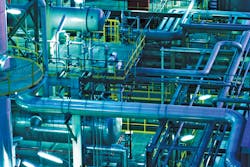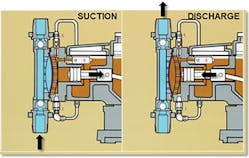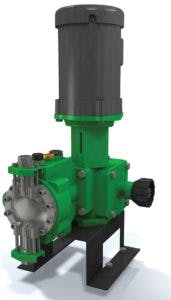Every day, almost everyone touches something made from chemicals. Man-made substances and compounds extracted from nature contribute to the planet’s prosperity in immeasurable ways, but chemicals can also be harmful to people and the environment, so great care must be taken to ensure that chemicals are precisely dispersed in any manufacturing process.
Metering pumps play a key role in dosing chemicals that are often procured and stored in high concentrations. Much like a needle that delivers medicine, a metering pump is far less expensive than the material it handles, but it must accurately deliver precise volumes every time — or problems can result.
How hydraulically actuated diaphragm metering pumps work
Metering pumps are positive displacement chemical dosing devices that vary capacity as required by the process. Their high level of repetitive accuracy is capable of pumping a wide range of chemicals, acids, bases and corrosive or viscous liquids.
Chemicals enter the "liquid end" when the pump’s motor drives a piston to create a vacuum that sucks chemicals into the pump from external tanks. Alternating piston strokes create pressure that closes the inlet valve, opens the outlet valve and forces the liquids out to the process. Within the liquid end is a diaphragm, which acts as a barrier between the piston and the process fluid (see Figure 1). The piston is either in direct contact with the process fluid or is shielded from the fluid by a diaphragm.
The piston’s pumping motion is applied to hydraulic fluid, which causes the diaphragm to flex back and forth as the piston reciprocates. The movement of the piston — called deflection — flexes the diaphragm between concave and convex positions. The periphery of the diaphragm is clamped and does not move during the deflection. The greater the deflection of the diaphragm, the higher the flow rate for the pump.
The rate of flow can be precisely controlled by varying the speed of the motor or by adjusting the length of the piston stroke (either manually or remotely), ensuring that the process receives just what it needs, without over or under injecting — much like a prescribed dose of medicine delivered by a needle.
Common applications for metering pumps
Metering pumps are widely used in refineries, power plants, chemical and petrochemical plants and in all types of manufacturing processes. One of the biggest uses for metering pumps is to treat water. Many plants are located near rivers because they require enormous volumes of water for cooling and other processes. These plants cannot control the quality of incoming water, which varies due to storms or to man-made interventions, so incoming water must be treated before it is suitable for use. The typical applications where metering pumps are used include the following:
Disinfection — is accomplished by precisely dosing chemicals such as sodium hypochlorite (bleach). When sodium hypochlorite comes in contact with bacteria, it oxidizes molecules in the cells of the germs and kills them. Even though this simple but harsh chemical has been used for more than a hundred years, it is prone to causing problems for pumps by off-gassing. Metering pumps must be able to pass the gas bubbles through the pump head to minimize the likelihood of a loss-of-prime due to off-gassing.
pH adjustment — is needed because the majority of processes in plants operate best when the pH of the water used is neutral (pH-7). Specific volumes of acids, such as sulfuric acid, and caustics, such as sodium bisulfate, are dosed via metering pumps to lower or raise water pH. But not all applications require a neutral pH. Cooling tower water is susceptible to Legionella, which can be resistant to standard disinfection treatments. Different halogens, such as bromine, work best at higher pH levels (8.5 to 9). This is just one example where plants need to vary pH treatments to find where their processes work most effectively.
Corrosion inhibitors — (amines and other substances) are dosed throughout plants to prevent scaling and fouling that could damage plant infrastructure and impede the performance of boilers, cooling towers, steam turbines and other equipment.
Flocculants and coagulant chemicals — are dosed via metering pumps into large mixing tanks where the positively charged chemicals bond with negatively charged ions in water particles. This bonding precipitates particles into larger groups that settle on the bottom of the tank, making them easier to filter out.
Given the metering pump’s importance in the plant, it cannot fail. Operators should be mindful of certain criteria that today’s metering pumps should adhere to.
Common criteria for metering pumps
Accuracy — Diaphragm metering pumps should provide 1,000-to-1 turndown capabilities with steady-state accuracy down to +/- 0.5 percent. Most chemicals are procured in concentration, and they must be metered accurately — not just to save money but to ensure that overdosing is prevented. For example: Sulfuric acid, which is used to lower pH, is harsh on plant equipment, and injecting too much acid results in an improper pH and can damage a boiler or cooling tower — just like injecting too much medicine would not serve a patient properly.
Corrosion resistance — In many plants, metering pumps must be API 675 compliant. They must be able to deliver a wide range of harsh and corrosive chemicals, such as biocides, cleaning compounds, coagulants, corrosion inhibitors, defoamers, oxygen scavengers, polyelectrolytes, scale inhibitors, emulsion breakers and many other chemicals. Pumps must be able to handle the diverse characteristics of these chemicals, and they must be able to pump chemicals at different concentrations and temperature levels.
To accommodate this diversity, all the wetted parts of the pumps’ liquid end should be available in 316 stainless steel, alloy 20, PVDF or PTFE. The ability to leverage a single pump family that can be configured with different materials not only adds flexibility but it also helps suppliers meet a plant’s delivery deadlines.
Recent metering pump innovations are designed to simplify commissioning and help the pump survive upset conditions.
Longevity and reliability — Plants like refineries run continuous operations, and downtime is avoided at all costs. Hydraulically actuated double diaphragms — with leak detection capabilities — operate with equal pressure between the hydraulic and process fluids, which eliminates diaphragm stress and provides unmatched longevity, enabling these types of pumps to operate for 20 years or more with minimal maintenance. In offshore environments, reliability is paramount because upstream platforms in remote locations are difficult to reach and maintenance is more expensive.
Safety — Safety goes hand-in-hand with reliability. When choosing a pump, look for fewer potential points of failure to minimize maintenance and to ensure a higher level of safety for plant employees. Exposure to chemicals, such as chlorine gas, can cause respiratory issues for workers. Chemicals like sodium hypochlorite are typically used in concentrations 10-times the strength of household bleach. If a pump leaks, the chemicals being pumped can corrode parts of the system. Great care should be taken to eliminate leaks when dosing hazardous chemicals. A pump’s design and its construction materials have a lot to do with the safety and the longevity of the pump.
Predictive maintenance — Predictive maintenance involves planning, scheduling, condition monitoring, analysis and spare-parts management. Predictive maintenance for pumps is aided by smart-sensing technology that can alert engineers to dry-run conditions, temperature changes, increases in vibration or decreases in pressure. Predictive maintenance can also be done without advanced communications technology. Readily available information and historical pump performance can be used to schedule the replacement of wear parts in a manner that causes minimal disruption to plant operations. Spare-parts inventories should be easy to manage, and part kits should contain everything a pump needs with just one part number.
Several other metering pump innovations have been brought to market in recent years, which are designed to simplify commissioning and startup as well as enhance the pump’s ability to survive upset conditions. Many of these innovations are practical and simple, such as 4-bolt tie bars that add stabilization to valve assemblies; push-to-purge valves that maintain hydraulic balance and remove air while purging excess oil; and mechanical refill hydraulic systems that replenish hydraulic oil on suction strokes and eliminate the need for adjustable oil makeup valves.
Conclusion
The chemicals metered throughout plants are the lifeblood of the operation. By evaluating pump criteria and pairing it with operational requirements, plants can be sure that they are receiving the right "medicine" in the right doses they need to keep their plants running at optimal efficiency.





